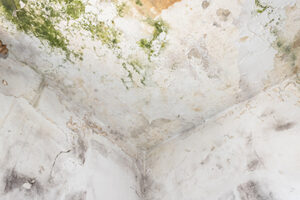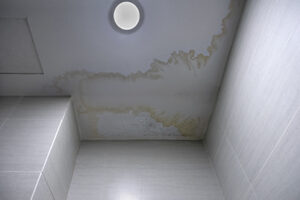Mold vs. Mildew on Walls: What You Should Know
Most homeowners have had at least one experience with mold and/or mildew on their wall. I have personally dealt with both and neither is an ideal guest in your home. Up until recently, I had assumed they were the same thing but they have some key differences. In today’s article, I will go over the differences and how to get rid of them!
First off, what is the difference between mold and mildew? Well, both are considered fungi and have similar characteristics. They grow rapidly in warm moist environments where they feed on organic material. However, mold is the same species as mushrooms while mildew is not.
Mold typically appears as green or black spots that can appear fuzzy, slimy, or scaly. This fungus occurs naturally outside but can also grow when spores land on surfaces indoors and start to multiply.
Mildew is often found in bathrooms and kitchens and appears as a powdery-like substance that is caused by an airborne spore landing on moist surfaces. It will eventually develop into unsightly spots of discolored, faded, or peeling paint.
Again, both can be a nuisance, and thankfully both can be dealt with too. Let’s talk about them more and some tips I have for getting rid of them!
What Causes Mold?
Mold is mostly found outdoors in dirt, plants, and trees. Over time, spores land on surfaces that are moist or wet and these spores then begin to multiply. However, mold can also form inside of our homes.
Here are a few of the most common ways mold can grow in the home:
- Clogged gutters or exterior walls with not enough ventilation
- Roof leaks
- Leaky pipes under sinks or behind toilets
- Bathrooms with poor ventilation and moist floors
- Basements without proper drainage
Although mold isn’t a reason to immediately panic, it does need to be addressed. More on why and how later on in the article.
 What Causes Mildew?
What Causes Mildew?
Mildew is often the result of over-moisture. It tends to thrive in warm, damp environments which is why it appears on bathroom surfaces and near sinks or tubs. We already mentioned that mildew can be spotted easily but here are some other signs you might see:
- Faded colors appear on paint
- A musty smell in your bathroom
- Peeling paint
- Surface flaking or chipping
Again, although mildew can be unsightly and annoying, it won’t harm you. However, if left untreated for a long period it could cause damage to the material it is growing on.
Why Mold and Mildew Are Problematic
If you are noticing either or both of these problematic fungi growing in your homes, you should make every attempt to get rid of them. Mold and mildew can cause a variety of health problems:
- Eye irritations
- Skin irritations and rashes
- Allergy flareups
- Respiratory issues such as coughing, wheezing, and asthma-like symptoms
- Headaches and migraine flareups
The main message is that mold and mildew need to be addressed as soon as possible. It’s important to address them regardless of your health concerns because they can cause problems even if you’re not dealing with reactions! However, if you are dealing with health issues, you should get rid of them.
How To Get Rid Of Mold
Now that we know more about what mold is and how it grows, let’s talk solutions! These solutions will vary depending on your situation and the severity of the mold.
Here are a few of my own tried and true methods for getting rid of mold:
- Use a commercial mold removal product.
- Vacuum and wipe down surfaces with a solution of vinegar and water. You can also add a little bit of lemon juice to this solution!
- Wipe down the affected area thoroughly with rubbing alcohol.
- Use a solution of 10% bleach and water.
- Use a commercial enzyme cleaner.
- Hire a professional if the problem is too great to handle on your own.
 Mold is a persistent fungus and it needs a lot of attention to rid your home of it! Keep in mind that mold can eventually return so you have to make sure the area is completely dry before sealing it.
Mold is a persistent fungus and it needs a lot of attention to rid your home of it! Keep in mind that mold can eventually return so you have to make sure the area is completely dry before sealing it.
How To Get Rid Of Mildew
Getting rid of mildew is much easier than getting rid of mold. Again, the solution will depend on your situation but here are some options for you to consider:
- Use a commercial mildew removal product.
- Combine water and bleach in a 50/50 mix and soak items in this solution for 30 minutes.
- Wipe down the affected area with a vinegar and water solution.
- Use a commercial enzyme cleaner
- Boil clothes in hot water for 15 to 20 minutes if they cannot be washed.
- Place items in direct sunlight to dry. This will kill the mildew spores and stop growth.
Mildew is easier to handle than mold, but you should still take care not to let it grow.
How To Prevent Mold And Mildew
In my home, I have come across both mold and mildew. Because of this, I have been extra careful when it comes to moisture. So before either problem has time to surface there are some preventative steps I take.
- Always take a dehumidifier or fan into any room that will be closed up for a while (such as the bathroom during winter) to allow the room to dry out.
- Don’t ever let water sit on or near surfaces overnight and don’t keep wet clothing in your laundry hamper for more than a day (wash it!).
- Always wipe down appliances such as the stove, refrigerator, and dishwasher to remove any moisture.
- Make sure you turn off any running water when you are not using it, especially when it’s in pipes that are hidden.
- Have a professional clean appliances that have been soaked in water or that have mold in them.
- For the bathroom, try to keep the moisture in check by opening windows when taking showers and leaving them open while you’re not in there. Using fans will also help dry things up!
- Keep your home ventilated well. This means opening windows occasionally during the day. You can even invest in a device that attaches to your window and helps keep it propped open!
Which One Is More Common?
When it comes to your home, are you more likely to deal with mold or mildew? Well, in my experience, mildew is more common than its fungal relative. The main reason I see mildew more commonly is because of the moist environments it loves to grow in.
And, since a bathroom is a very moist environment, I tend to find mildew there often. Again, mildew isn’t a cause for concern and can be easily removed!
Is Mold And Mildew Dangerous For Children And Pets?
Mold and mildew can be harmful to your health if you inhale the spores. Take care when removing either problem from your home. If the area has been contaminated with mold or mildew, ensure that any other areas in your house where there is carpeting are free of these problems too since carpets allow for moisture to build up and mildew to grow.
As a parent, it is important to take necessary precautions when dealing with any kind of mold or mildew. Children are more susceptible to the dangers of mold and mildew so you need to be even more careful if they’re involved.
If your child has been in contact with mold or mildew, ensure they have a clean environment to play in and clean clothes to wear. Kids’ bath toys are very susceptible to mold growth so make sure to check them regularly and dry them out after each use.
 Signs You Have A Mold Or Mildew Reaction
Signs You Have A Mold Or Mildew Reaction
People react to mold and mildew in different ways. Again, untreated mold or mildew can cause health problems. Some of the most common things to look for are:
- Wheezing and coughing
- An itchy throat or nose
- Sneezing
- A runny nose
- Headaches that are worsened with activity
- Rashes on the skin, especially the face area.
If you notice any of these symptoms, then there may be mold in your home somewhere. Seek medical attention immediately to help stop the spread of mold. Then contact a professional to come to check your home for mold.
Can Mildew Spread To Other Areas?
Can mildew spread to other areas of your home? The answer is yes! Mildew can grow on clothing, carpeting, grout in a tile floor, and even paper! Although it’s not toxic to humans when in small amounts, having mildew on any of these surfaces means you need to take action.
In some cases, you may need to throw away any porous objects that have been contaminated with mildew. Seek professional help and follow their cleaning instructions and recommendations for safe removal and disposal of the items so as not to worsen the situation by spreading spores.
Should I Put De-Humidifiers In My Home?
An article on mold and mildew wouldn’t be complete without discussing de-humidifiers. Many people put them in their homes to keep the humidity levels down, especially during summertime when there’s a higher level of humidity outside.
De-humidifiers can certainly be helpful when moisture levels become high. So, if you want to try one out, make sure to keep it in an area where it won’t be knocked over and change its filter once a month.
So now you have all there is to know about mold and mildew! As you can see, they are like sisters with a couple of key differences. I hope you feel better prepared to look for and remove mold and mildew from your home now. Keep this article as a reference for any future problems you may have with these pesky visitors. Good luck!
